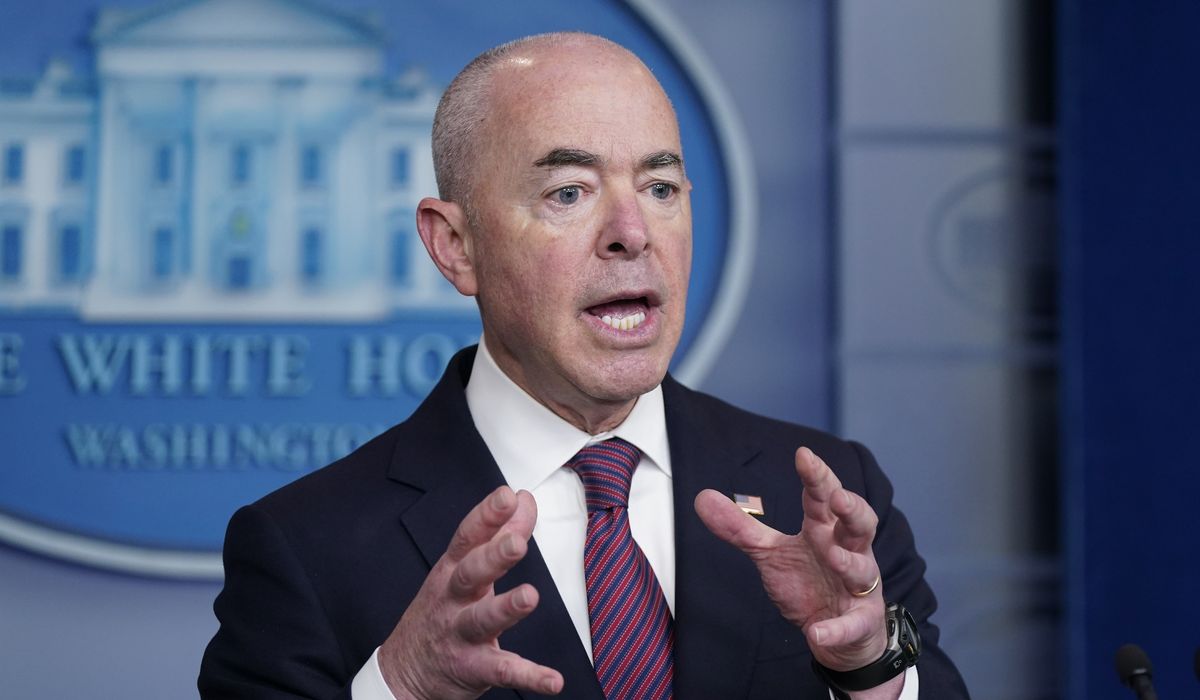
Being in the U.S. illegally is no longer enough to earn deportation, Homeland Security Secretary Alejandro Mayorkas said Thursday, releasing new guidelines that limit Immigration and Customs Enforcement targets for arrest and ouster from the country.
With Democrats in Congress trying to legalize most illegal immigrants, Mr. Mayorkas said, pursuing them would be working at cross-purposes.
National security threats and those deemed risks to public safety remain priorities, as is anyone who jumped the border after Nov. 1. That’s similar to the rules ICE had been following since interim guidance came out in February.
But Mr. Mayorkas changed the public safety category to a broader assessment of criminal history. He told officers that if anyone was hurt or weapons were used, it weighs in favor of arrest. If they have been in the U.S. a long time or ousting them would hurt their families, that should weigh against arrest or deportation.
“For the first time, our guidelines will, in the pursuit of public safety, require an assessment of the individual and take into account the totality of the facts and circumstances,” the secretary said in a statement announcing the rules.
Under the law, ICE is supposed to try to deport those in the country without authorization. Some cases are deemed mandatory based on the level of the criminal offense.
But given the estimated 11 million illegal immigrants in the U.S., decisions about targets have to be made. The Biden administration says it is using prosecutorial discretion to decide whom to target.
The Trump team also set priorities and said when it went after someone, it was because they had a criminal record. But ICE at the time also said anyone in the country illegally was subject to arrest and deportation.
Mr. Mayorkas’ rules mark a break with that practice, effectively carving most illegal immigrants out of any danger of removal.
He said that’s particularly true at a time when illegal immigrants are working during the COVID-19 pandemic.
“As we strive to provide them with a path to status, we will not work in conflict by spending resources seeking to remove those who do not pose a threat and, in fact, make our nation stronger,” the secretary said.
Mr. Mayorkas’ changes managed to disappoint both sides in the immigration debate.
CASA, a major immigration advocacy group in the mid-Atlantic region, said some of the changes were improvements and praised Mr. Mayorkas for drawing a line on illegal status not being a reason for deportation.
But Nick Katz, the group’s legal director, said he was “deeply disturbed” that the Biden administration didn’t go further.
“This guidance will ensure that thousands of immigrants every year are funneled into an inhumane detention system that cages asylum seekers, while fighting for their lives in courts where the odds are stacked against them — if they ever even get to see an immigration judge at all,” he said.
Those who want stricter immigration enforcement, meanwhile, said Mr. Mayorkas created a loophole in immigration law, granting a pass to most illegal immigrants.
“All illegal aliens, not just those who have committed a violent crime, need to understand that they are potentially going to be deported if the goal is to discourage illegal immigration,” said Jon Feere, a chief of staff at ICE in the Trump administration. “These guidelines could only be written by people who believe what’s happening on our border is perfectly acceptable.”
Mr. Feere, now the director of investigations at the Center for Immigration Studies, said the premise of the new rules is that “most foreigners have a right to ignore our nation’s laws whenever they please.”
ICE arrests and deportations at the beginning of the Biden administration dropped to their slowest pace on record.
Mr. Mayorkas said numbers aren’t as important as who’s being ousted. While overall arrests may be down, ICE told a federal judge this year that the processing of immigrants with aggravated felony convictions was up 65% under President Biden.
Arrests of illegal immigrants are relatively rare. In 2020, ICE’s deportation force made just 103,603 administrative arrests, 90% of whom had criminal convictions or pending charges when they were nabbed.
But the Biden administration is under intense pressure from immigrant rights advocates to cut those numbers even deeper.
Mr. Mayorkas said he developed the new guidance after extensive consultations around the country. He has met with immigrant rights activists and ICE employees. Victims of illegal immigrant crime had demanded meetings as well, though it’s not clear those took place.
The Washington Times this spring made an expedited open-records request for Mr. Mayorkas’ schedules to try to review his meetings, but the request for expedited processing was denied and the records have not been turned over.
Most ICE arrests come in prisons and jails, where officers find people in the country illegally who have been booked for other criminal offenses.
The Trump administration saw them as generally fair game, but the Biden team says it’s not that simple.
The balancing act for arrests under the public safety category of Mr. Mayorkas’ new priorities is particularly complicated.
He said there are no longer any “bright lines,” but officers must make individual assessments of each target’s criminal offenses and personal history.
Factors that could push toward deportation are the gravity of the offense, whether anyone was hurt or weapons were involved. Mitigating factors range from a lengthy history in the U.S. to hardship for a potential deportee’s family to whether the target or family members served in the military “or other public service.”
He said officers looking to make an arrest can’t rely on the arrest record alone, but should obtain the entire criminal record and judge the case in its entirety.
“The gravity of an apprehension and removal on a noncitizen’s life, and potentially the life of family members and the community, warrants the dedication of investigative and evaluative effort,” Mr. Mayorkas said in the guidance.








